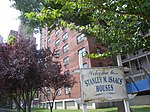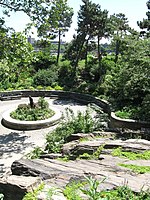The Municipal Asphalt Plant is a former asphalt plant at York Avenue and 91st Street on the Upper East Side of Manhattan in New York City, housing the Asphalt Green recreation center. The asphalt plant was completed in 1944 to designs by Ely Jacques Kahn and Robert Allan Jacobs. The current structure, originally a mixing plant, reopened as the George and Annette Murphy Center in 1984; it was attached to a conveyor belt and storage facility, both of which have been demolished. The Murphy Center is a New York City designated landmark and is listed on the National Register of Historic Places.
The Municipal Asphalt Plant's post-modernist design was intended to fit the residential character of the surrounding neighborhood while also being industrial. The mixing plant was the first parabolic-arched building in the United States to use reinforced concrete. The exterior was designed with four arched ribs, The walls and roof are made of cast-in-place concrete panels, which were poured around metal ribs. The conveyor belt and storage building were originally also made of reinforced concrete. The modern-day recreation center consists of the former mixing plant, now known as the George and Annette Murphy Center; the AquaCenter swimming complex; an outdoor field; and a former fireboat pier.
An asphalt plant had existed on the Upper East Side of Manhattan, along the East River near 91st Street, since May 1914. Manhattan borough president Stanley M. Isaacs announced plans for a three-level asphalt and sanitation plant on the site in 1939, and Kahn and Jacobs's plans were announced the next year. Work on the Municipal Asphalt Plant began in 1941, and the plant was dedicated on May 24, 1944. After the plant closed in 1968, the conveyor belt and storage facility were demolished. The New York City government announced plans to redevelop the site in 1971, but neighborhood residents heavily opposed the plan, establishing Asphalt Green on the site in 1973. A restoration of the mixing plant was announced in 1979 and completed in 1984. The recreation center has undergone various upgrades over the years, and a swimming center next to the Murphy Center was constructed in the early 1990s.









